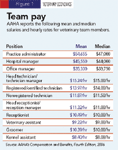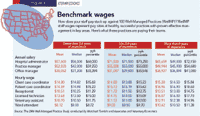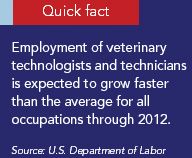Perfecting team pay
Are you paying your team too little, too much, or just about right given your location and their experience?
LESS THAN 10 PERCENT OF RESPONDENTS to an April 2005 VetMedTeam.com survey indicate that they earned a wage that was enough to provide adequate financial support for a family. Just over 25 percent made enough to support themselves. And more than 60 percent indicate that based on living expenses without excessive spending on luxury items, their salary isn't enough to allow them to live a financially stress-free life.

Of course, team members' pay depends on their experience, your practice type, and location, among other things. But if you constantly lose quality team members to better-paying practices, you may need to adjust your pay scale.
Trends
Veterinary assistants with fewer than three years of experience earned 14 percent to 18 percent higher wages than when surveyed in 2002, according to the 2006 Well-Managed Practice Study conducted by Wutchiett Tumblin and Associates and Veterinary Economics. And those with six or more years of experience saw an 18 percent to 27 percent increase. These were the most distinguished increases in staff wages in the last four years.

Figure 1
"We attribute this change to the expanding role of veterinary assistants in practice and recognition among owners of Well-Managed Practices that they need to offer fair-market wages to attract and keep the best and brightest employees," says study administrator Denise Tumblin, CPA, president of Wutchiett Tumblin and Associates in Columbus, Ohio.
Location
The top-paying states for technologists and technicians are Alaska, Connecticut, California, Michigan, and New Mexico, according to the Bureau of Labor Statistics. Top-paying metro areas are San Jose-Sunnyvale-Santa Clara, Calif.; Lansing-East Lansing, Mich.; Bridgeport-Stamford-Norwalk, Conn.; San Francisco-San Mateo-Redwood City, Calif.; and Santa Rosa-Petaluma, Calif.

Figure 2
Technicians in the metro area of San Jose-Sunnyvale-Santa Clara, make an average of $18.39 per hour, or $38,250 annually, while the national average is $12.84 per hour, or $26,710 annually. So it's easy to see that practice location affects team pay.
More than half of technicians in the lower Midwest, east of the Mississippi, are paid less than $10 per hour. According to the Wheretechsconnect.com 2004-2005 Vet Tech Salary Survey, this is a greater percentage than in any other region. However, the upper Midwest, west of the Mississippi, was the region with the greatest percentage of technicians paid more than $19 per hour with the exception of California. The greatest percentage of technicians making $11 or more per hour—90 percent—work in the upper west coast, according to the survey. (For more information on regional pay, see Figure 4.)
The concentration of qualified workers in an area may also affect their pay. The five metro areas with the highest concentration of veterinary technicians are College Station-Bryan, Texas; Gainesville, Fla.; Fort Collins-Loveland Colo.; Port St. Lucie-Fort Pierce, Fla.; and Durham, N.C., according to the Bureau of Labor Statistics.

Figure 3
In College Station-Bryan, Texas, the metropolitan area with the greatest concentration of veterinary technicians, the average hourly wage is only $8.04, or $16,720 annually.
Experience
According to AAHA's Compensation and Benefits released in 2006, the staff member position with the greatest percentage increase in pay between the least experienced and most experienced employees were receptionists; the more experienced receptionists made 39 percent more an hour—or $3.53.

Figure 4
Office managers saw the smallest percentage increase between levels of experience in the AAHA study, 20 percent or a difference of $2.74 per hour.
The average difference in pay between the most experienced and least experienced team members in the office manager, head technician/technician manager, registered technician, nonregistered/noncertified technician, head receptionist/reception manager, reception, and veterinary assistant positions is $3.14 per hour, according to the data. (See Figure 2).
Editors' note: Find more on team pay in "Does Your Revenue Carry Your Team" on this issue and "Reality Check: The True Cost of Living" on this issue.

Quick fact